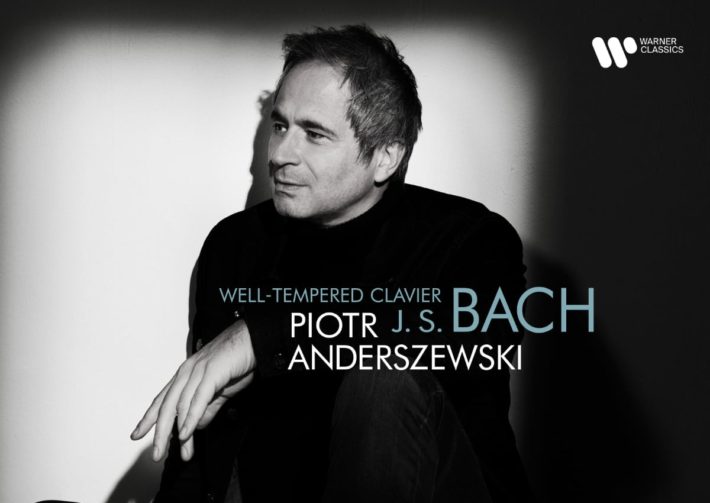Piotr Anderszewski describes the dilemma he faces performing Bach, wondering “to what extent [the] Prelude and Fugues…are suitable for the concert platform,” but at the same time wanting to “[offer] the listener almost limitless scope for exploration.” The solution he presents breaks from the convention of performing the two volumes of the Well-Tempered Clavier in their entirety. Instead, he chooses to focus only on Book II and puts together a handpicked selection of Preludes and Fugues, each with a distinct personality.
In his preface, the pianist mentions how he puts emphasis on using the voices in each fugue to display its architecture. The same can be said, however, in the C major Prelude (track 1). We immediately hear a deliberate emphasis on voice-leading and consistency between specific, recognizable patterns. At the same time, Anderszewski maximizes the versatility of the modern instrument’s timbres (with a discreet, almost imperceptible usage of the sustaining pedal) to create distinct flavors in different sections. A vivacious fugue follows suit (track 2), with the omnipresent sixteenth-note figures serving as a thread that ties it together.
The F minor that follows is an interesting choice, one that gives us a glimpse into Anderszewski’s interpretation of the works as character pieces. The Prelude (track 3) offers a soft-spoken commentary that is quite different from the declamatory C major. Clean two-note phrases, a mellow tone quality, and elegant ornamentation in the repeats create this light approach. The fugue has just the right amount of drive but still retains the refined clarity of the Prelude.
Related Classical Music Reviews
- Review: Bach – Goldberg Variations – Lang Lang, Piano
- Review: Bach – Lute Suites – Sean Shibe, Guitar
- Review: Bach – Complete Keyboard Edition Vol.3 – Benjamin Alard
The D-sharp minor pair (tracks 7-8) is a fine example of how the performer establishes a lyrical presence in the cycle. The prelude presents quite the musical challenge: play it too subtly and the listener gets lost in its quietness. Play it too expressively and its winding intricacies might overwhelm the ear. The performance, however, is both thoughtful and intelligent. With a well-placed emphasis on horizontal thematic movement within and between the voices, we are guided through Bach’s counterpoint. As a result, the prelude’s understatedness gradually opens up, giving way to the dynamic movement within. The 4-voice fugue shares a similar nuanced lyricism, but here Anderszewski creates a constant change in the work’s intensity to give it an overall shape: a gradual scaffolding of voices takes us to the climactic point at 2’55” while the accompanying denouement leads to the much desired resolution in the major key.
Contrast is the name of the game in the G# minor prelude (track 19): the pianist not only makes quick and seamless changes in the dynamics, but also goes further in treating the alternating loud and soft sections like two people engaged in a lively conversation. A brisk tempo and crisp articulation evoke a vitality which balances out some of the more introverted personalities elsewhere on the album. The calmly meandering fugue (track 20) is very much a complement to the previous track, seeming at times like someone deep in thought. If we listen closely enough, we can see that rhythmic consistency (albeit much slower and now in triple meter) is a similar defining feature as it was in the prelude.
The B major prelude (track 21) is perhaps the most extroverted character to appear in the set. The interpretation is quite different from, say, Angela’s Hewitt’s (Hyperion 2008), which is paced at a more measured tempo but is refreshing and airy. Anderszewski’s take certainly has a more robust demeanor but is not any less enjoyable – the upfront virtuosity has its hints of playfulness in the right moments. His fugue brings the different registers of the keyboard together in an orchestral fashion–the opening left-hand subject is deep and authoritative. Later on, we hear lighter filigree patterns (1’40”) in the upper voice that are of a completely different presence. Bringing his objective full circle, however, he doesn’t ignore the inner voices, whose counter-subjects forge the path we take through the work.
The sound engineers at Berlin’s Teldex Studio do a nice job capturing the natural warmth of the instrument as well as the minute gradations in the pianist’s tone. The liner notes, especially Anderszewski’s own forward, are worth reading to understand how and why he constructed this particular cycle. Insightfully conceived and presented, this album belongs on the shelf of any Bach enthusiast.

Bach – Bach – Well-Tempered Clavier, Book II (Excerpts)
Piotr Anderszewski – Piano
Warner Classics, CD 9029511875
Recommended Comparisons
Hewitt | Schiff | Fischer | Richter
Read more classical music reviews or visit The Classic Review Amazon store
Follow Us and Comment:
Get our periodic classical music newsletter with our recent reviews, news and beginners guides.
We respect your privacy.








